

|
 |
Nekromantik 2 AKA Nekromantik 2: Die Rückkehr Der Liebenden Toten (Blu-ray)
[Blu-ray]
Blu-ray B - United Kingdom - Arrow Films Review written by and copyright: Paul Lewis (22nd December 2015). |
|
The Film
 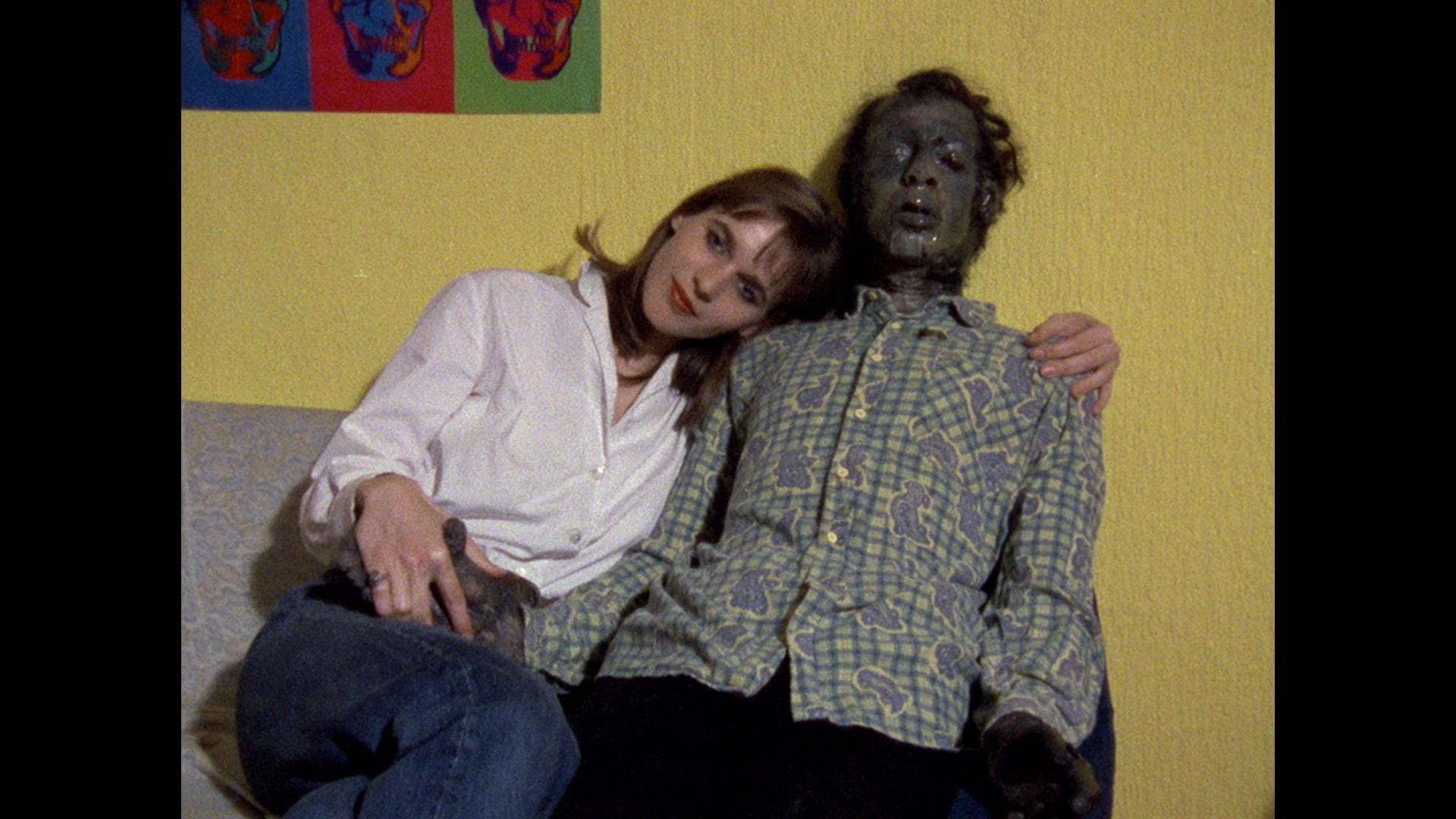 Nekromantik 2 (Jorg Buttgereit, 1991) Nekromantik 2 (Jorg Buttgereit, 1991)
Openly combative, Jörg Buttgereit’s debut feature Nekromantik (1987) made an impact both within West Germany – where the picture’s deliberate excesses challenged the strict codes of censorship that existed within West Germany at the time – and abroad, facing censorship and outright bans in a number of countries including Britain. After his second feature, Der Todesking (1990), Buttgereit returned to the territory explored in Nekromantik, making a direct sequel to his debut picture. Although featuring a new protagonist, this time a female, Nekromantik 2 (1991) followed on directly from the narrative of the first film – though where Nekromantik had been shot on Super 8mm, Nekromantik 2 was filmed in 16mm. In Germany (and, for that matter, elsewhere) Nekromantik 2 proved no less controversial than its predecessor, being seized by police in Munich following its first public screenings. The film, and by extension Buttgereit himself, was charged with glorifying violence. The film begins with Monika (Monika M), a nurse, exhuming the body of Rob, the necrophile depicted in the first Nekromantik, and returning his corpse to her apartment. There, Monika washes the body before mounting it and attempting to fuck it, but finding this impossible owing to the penis’ flaccidity. Her actions are intercut with the life of Mark (Mark Reeder), who works as a dubbing artist, dubbing American pornographic films into German. Mark and Monika come together when Mark arranges a date at the cinema but is stood up. He offers his spare ticket to Monika; together, they watch a bizarre art film, ‘Mon dejeuner avec Vera’. Afterwards, Mark invites Monika to his apartment, where he cooks for her. Mark and Monika soon form a relationship, visiting a funfair together. In light of her new relationship with Mark, Monika cuts up the corpse of Rob, disposing of all the body parts except the head and the penis, the latter of which she keeps in a plate in her refrigerator. 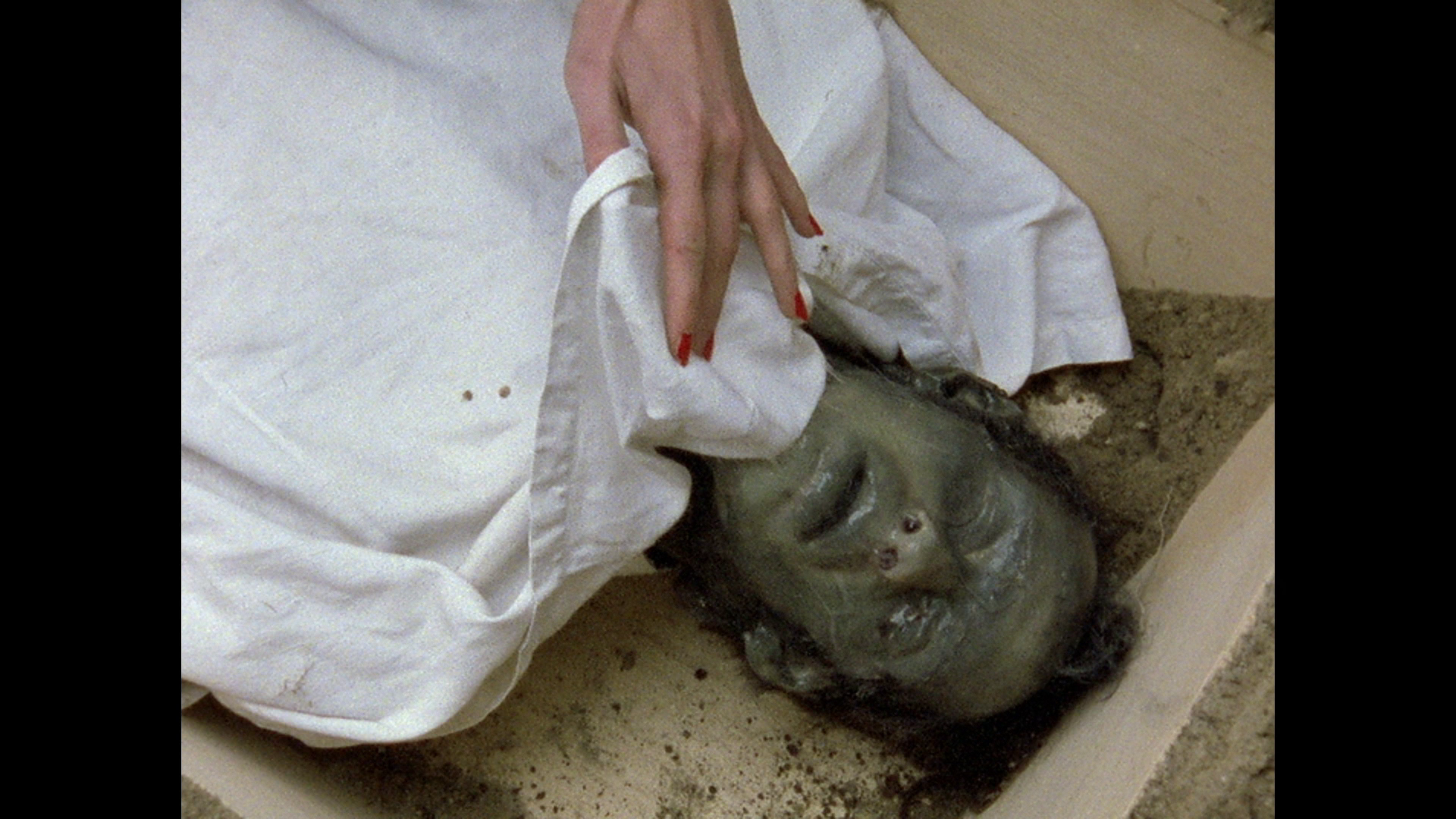 Mark soon proves himself to be a disappointment in bed. Monika seeks solace in her apparently likeminded friends, who visit her apartment and, together, watch a videotape featuring the skinning of a seal. Mark arrives, and Monika hides the tape and Rob’s severed head. He asks what Monika and her friends were doing, and with some resistance she eventually agrees to show him the videotape they were watching. Unable to reconcile their different passions, the pair break up. A montage shows them reflecting on their relationship; Monika eventually reconciles with Mark, allowing him to return to her bed. However, she has one final shock for him. Mark soon proves himself to be a disappointment in bed. Monika seeks solace in her apparently likeminded friends, who visit her apartment and, together, watch a videotape featuring the skinning of a seal. Mark arrives, and Monika hides the tape and Rob’s severed head. He asks what Monika and her friends were doing, and with some resistance she eventually agrees to show him the videotape they were watching. Unable to reconcile their different passions, the pair break up. A montage shows them reflecting on their relationship; Monika eventually reconciles with Mark, allowing him to return to her bed. However, she has one final shock for him.
Buttgereit’s films are highly divisive, with viewers either embracing the pictures as examples of art-horror cinema or dismissing them as distasteful or pretentious (or both). Randall Halle situated Nekromantik 2 within a subgroup of films he labels as examples of ‘Unification Horror’ – that is, German horror films of the reunification period. Halle suggests that Buttgereit’s film had ‘a particular uncanny ability to provoke its spectators’ (Halle, 2003: 291). This was the reason for its ban under Section 131 of the Strafgesetzbuch/Penal Code, which prohibits representations of violence that ‘describe cruel or otherwise inhuman acts of violence against human beings in a manner which expresses a glorification or rendering harmless of such acts of violence or which represents the cruel or inhuman aspects of the event in a manner which injures human dignity’ (Strafgesetzbuch, s.131). For Kris Vander Lugt, Nekromantik and its sequel ‘virtually [explode] generic borders and [launch] a no-holds-barred assault on bourgeois notions of propriety and decency’ (Lugt, 2013: 166). Halle suggests that ‘[a]midst the ever increasing explosions and murders of popular films from Hollywood’, the censorship of a picture such as Nekromantik 2 ‘marks the success of the techniques of abjection and the film as a specific site of cultural anxiety’ (Halle, op cit.: 291). Halle cites Knut Hickethier’s defence of the film, which in 1994 led to the ban on the picture being lifted: Hickethier claimed the film was a ‘metaphorical interpretation of the decline of East Germany and the effects of the Berlin Wall coming down’ (Hickethier, quoted in ibid.). In the documentary included on this release, Buttgereit, Mark Reeder and Monika M argue that this wasn’t at the forefront of their thinking when making the picture, but as Monika M argues, even though she doesn’t agree with Hickethier’s interpretation of the picture, ‘It’s an interpretation; and that’s what art is for, to be interpreted’. 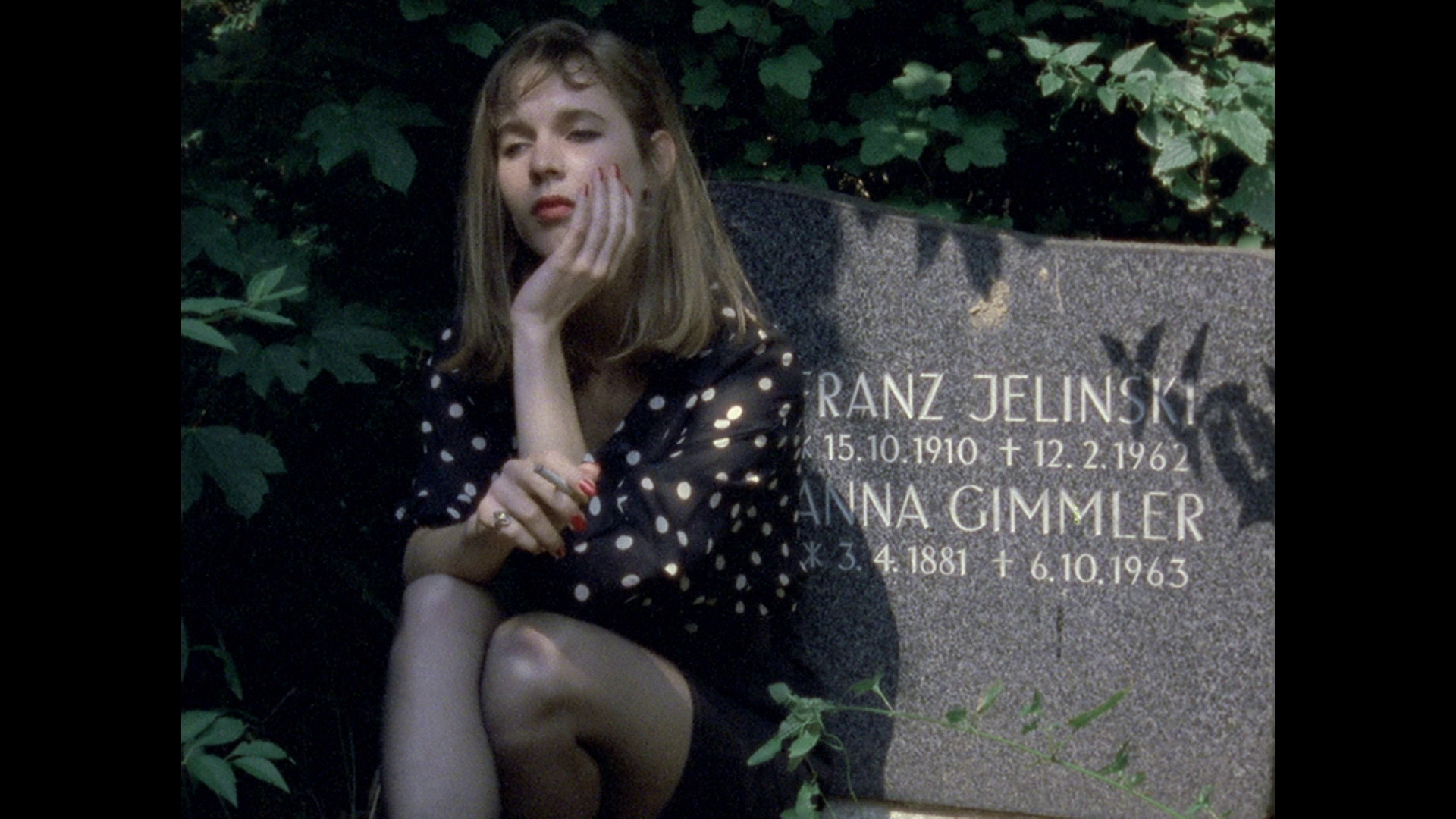 Buttgereit opens Nekromantik 2 with a quote from Ted Bundy (ascribed to ‘Theodore R. Bundy’), ‘I want to master life and death’. The film’s combative tone is thus established from the outset, followed by a précis of the first film’s conclusion, the footage post-processed into monochrome and intercut with Nekromantik 2’s opening credits. The footage from the first picture shows Rob committing suicide on his bed, burying a knife into his stomach whilst his (prosthetic) erect penis ejaculates first semen and then blood. After the credits, the audience is presented with a series of disconnected shots of a woman walking through a cemetery, her journey presented via point of view shots from her perspective (shot with a handheld camera) and interspersed with shots of her body, fragmented by the camera – and without her face visible. The woman is, of course, Monika; she’s dressed as if for an evening out, in a short black skirt, blouse, red cardigan and high-heeled shoes, with fresh red nail varnish on her fingernails. She approaches a grave, Rob’s grave, and begins to dig with a pickaxe and a shovel. Via an overhead shot of the grave, we see her open the coffin, and on the audio track we hear her breathe as she peels back the white sheet to reveal the putrefying corpse of Rob beneath. Buttgereit opens Nekromantik 2 with a quote from Ted Bundy (ascribed to ‘Theodore R. Bundy’), ‘I want to master life and death’. The film’s combative tone is thus established from the outset, followed by a précis of the first film’s conclusion, the footage post-processed into monochrome and intercut with Nekromantik 2’s opening credits. The footage from the first picture shows Rob committing suicide on his bed, burying a knife into his stomach whilst his (prosthetic) erect penis ejaculates first semen and then blood. After the credits, the audience is presented with a series of disconnected shots of a woman walking through a cemetery, her journey presented via point of view shots from her perspective (shot with a handheld camera) and interspersed with shots of her body, fragmented by the camera – and without her face visible. The woman is, of course, Monika; she’s dressed as if for an evening out, in a short black skirt, blouse, red cardigan and high-heeled shoes, with fresh red nail varnish on her fingernails. She approaches a grave, Rob’s grave, and begins to dig with a pickaxe and a shovel. Via an overhead shot of the grave, we see her open the coffin, and on the audio track we hear her breathe as she peels back the white sheet to reveal the putrefying corpse of Rob beneath.
Halle notes that the framing of the film’s opening sequence, which offers glimpses of Monika’s walk into a through the cemetery without allowing a full body shot of her or a close-up of her face is ‘typical of horror films’ in ‘remain[ing] tight, dissecting her [Monika’s] body, preventing any overview’ (Halle, op cit.: 293). The ‘lack of visual plenitude’ within this sequence ‘forecloses the possibility of any sense of spectatorial control’, offering photography in which the ‘camera clearly calls the shots, according to a logic that is exterior to our own’ (ibid.). The audience is asked ‘to piece together the bits of information offered by these shots’, but this is challenging because of the juxtaposition of the way that Monika is dressed (‘as if for a date’) and the context in which we encounter her (walking through the cemetery, then exhuming a corpse) (ibid.). 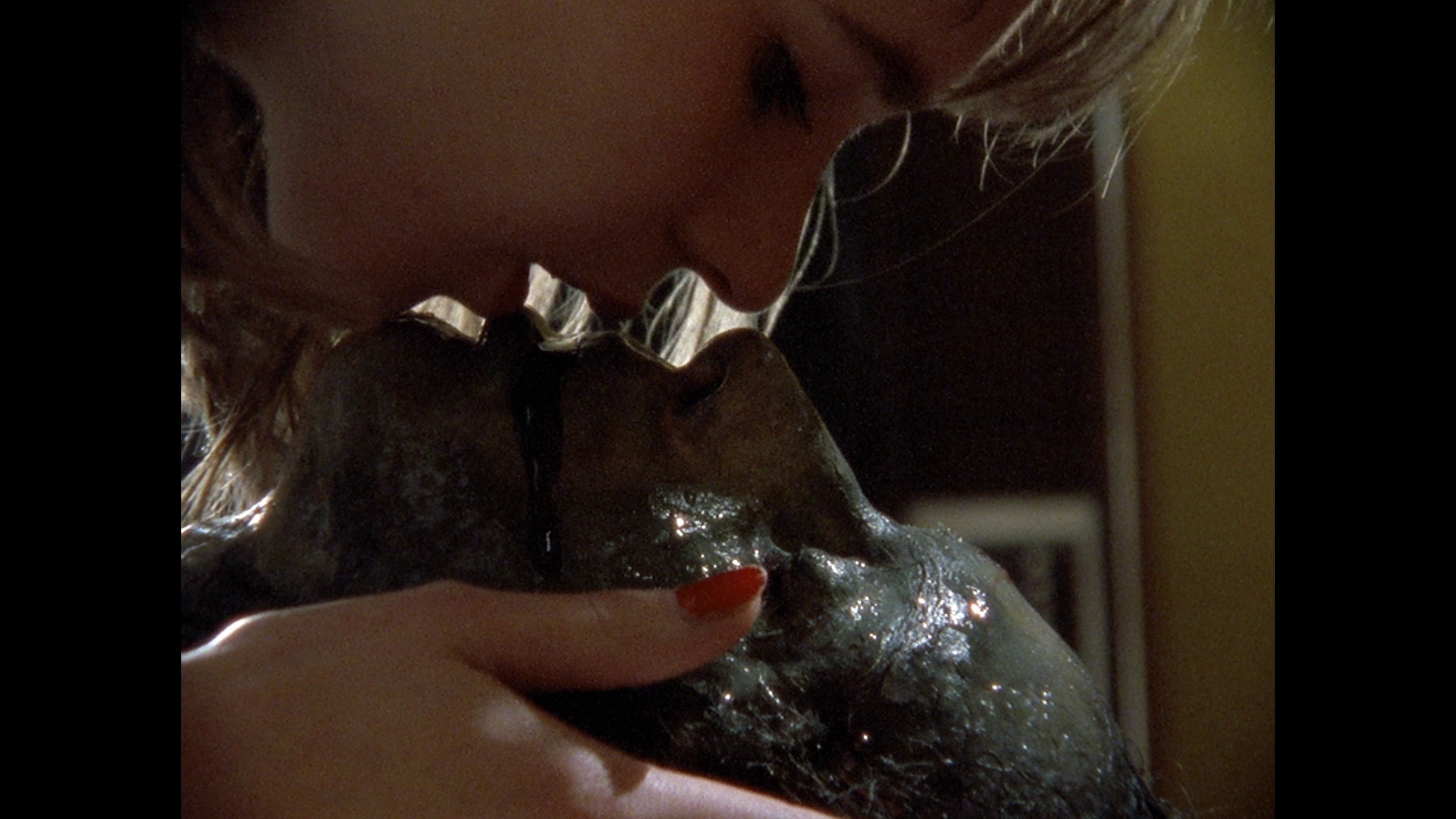 The film is deeply blackly comic, in its depiction of Monika’s fascination with Rob’s corpse and her attempt to build a relationship with it/him. She uses a tripod and a Polaroid camera to produce a photograph of the both of them together, reclining comfortably on the sofa, her arm around his body. The most disturbing moments within the film focus on Monika’s attempts to fuck the corpse, with the transference of fluids from Rob’s rotting body – when Monika gives him an open-mouthed kiss, for example – offering the most viscerally unsettling imagery within the picture owing to the transgression of the widely-held taboo that revolves around our physical relationship with the abject. Monika kisses the corpse on the lips, pushing her tongue between its lips; when she moves her head away, a string of fluid briefly connects the mouths of Monika and Rob. It’s this aspect that seems to disturb even Monika, and in a sequence that is notable for Buttgereit’s uncharacteristic attempt to represent it elliptically, Monika sits astride Rob’s chest and lowers her head towards the corpse’s crotch. Buttgereit doesn’t show the moment of contact, but the intention is clear: that Monika is performing fellatio on Rob’s decaying body. However, Monika soon dismounts the corpse and runs to the bathroom, vomiting into the lavatory. The film is deeply blackly comic, in its depiction of Monika’s fascination with Rob’s corpse and her attempt to build a relationship with it/him. She uses a tripod and a Polaroid camera to produce a photograph of the both of them together, reclining comfortably on the sofa, her arm around his body. The most disturbing moments within the film focus on Monika’s attempts to fuck the corpse, with the transference of fluids from Rob’s rotting body – when Monika gives him an open-mouthed kiss, for example – offering the most viscerally unsettling imagery within the picture owing to the transgression of the widely-held taboo that revolves around our physical relationship with the abject. Monika kisses the corpse on the lips, pushing her tongue between its lips; when she moves her head away, a string of fluid briefly connects the mouths of Monika and Rob. It’s this aspect that seems to disturb even Monika, and in a sequence that is notable for Buttgereit’s uncharacteristic attempt to represent it elliptically, Monika sits astride Rob’s chest and lowers her head towards the corpse’s crotch. Buttgereit doesn’t show the moment of contact, but the intention is clear: that Monika is performing fellatio on Rob’s decaying body. However, Monika soon dismounts the corpse and runs to the bathroom, vomiting into the lavatory.
In Monika’s first attempt at coitus with Rob’s corpse, the dead body of Rob is ‘imbue[d] with a certain subjectivity by [the camera] focus[ing] on its open eyes’; Halle argues that this technique ‘intensifies the fascination of the abject’ (Halle, op cit.: 293). As Monika mounts the corpse, Buttgereit cuts to the studio in which Mark and his female colleague (Lena Braun) are dubbing into German an American porn film. This scene begins with a shot of the film which Mark and his female associate are dubbing, which ‘gives the momentary appearance’ to the viewer of Buttgereit’s film, ‘that Rob has come back to life and that the film [Nekromantik 2] is a fantastical film’ (ibid.). It is only gradually that the true setting of this scene is revealed: ‘a dubbing studio for sex films, one of the postwall centers of economic “success”’ (ibid.). The scene in the dubbing studio, which appears twenty minutes into the film, features the film’s first ines of dialogue. The lines that Mark and his colleague are asked to speak are so clichéd as to be ridiculous (‘That’s so good’; ‘I’m so horny. Come on, let’s fuck’); they are criticised by the American producer, who sits in a booth and announces, ‘That wasn’t quite in synch. Can we do it with a little more effort, please?’ Mark and Monika’s first sexual encounter together is also presented in an ironic manner. The sex scene is depicted through alternating point of view shots taken from the perspective of both of the participants. Mark’s ‘underperformance’ here is contrasted with his work as a dubbing artist for porno pictures: whilst fucking Monika (with his socks still on), Mark remains passive, pinned beneath her, contorting his face comically and making pathetic gasping noises which offer an ironic counterpoint to the aggressive grunting and ‘dirty’ talk which he practises in the dubbing studio. Monika is visibly unimpressed, having ‘dumped’ (literally) her previous boyfriend, Rob (or rather, Rob’s corpse), for her new lover. The ‘reality’ of sex is thus contrasted with the artifice of pornography. When, afterwards, Mark looks for a bite to eat and opens Monika’s refrigerator to discover Rob’s genitals on a plate, he gradually realises what he is looking at and instinctively grabs his own genitals in a defensive gesture. He meets a female friend in a coffee shop and tells her about his new relationship but confesses ‘I think she’s [Monika is] somehow perverse’. Mark’s friend jokes, ‘I would have thought in your job, you got to see everything’. In response, Mark tells his friend that when he and Monika have sex, ‘she doesn’t want me to move at all’. 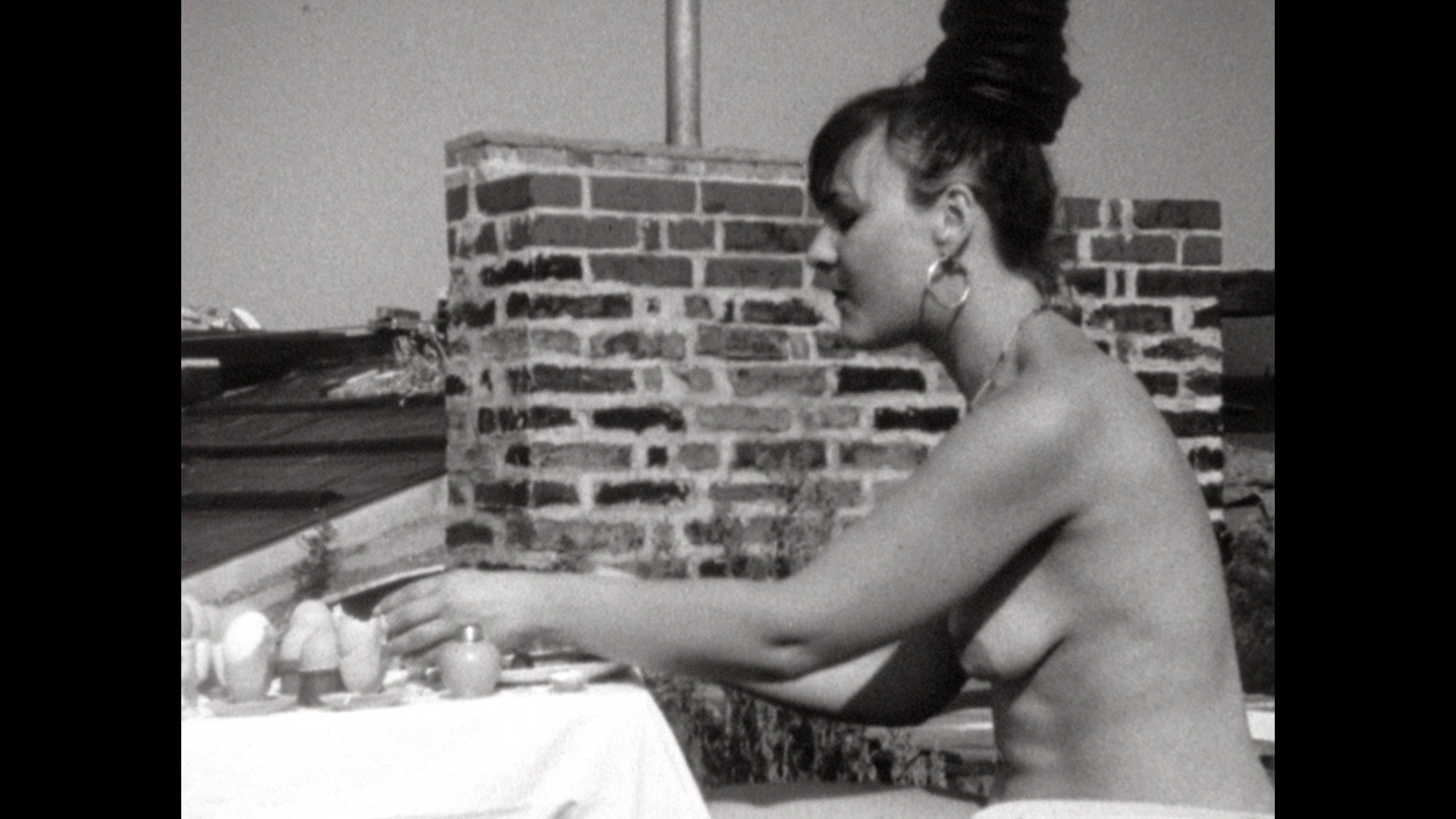 Roland Halle suggests that the films of Buttgereit ‘do not proceed at the same pace as those of’ his many contemporaries; Buttgereit’s pictures ‘have a slowness that concentrates on establishing atmosphere and mood’ (Halle, op cit.: 293). However, the films have ‘a profound ability to disturb’ that is achieved ‘precisely […] through these idiosyncratic techniques’ (ibid.). One of the techniques Buttgereit uses is a self-referential mixture of different media and the use of films-within-films as a metafictional strategy: in Nekromantik 2, for example, Buttgereit has Mark work at a studio dubbing American pornographic films, intercutting Monika’s first attempt at coitus with the corpse of Rob with a dubbing session in which Mark (and a female colleague) attempt to dub a porno film into German. (This includes Rob slapping his fingers against the palm of his hand, whilst uttering ridiculous phrases, in mimicry of the flesh-against-flesh contact which is taking place in the film that he is watching in the dubbing studio.) Later, Mark meets Monika at a cinema where they watch a film, ‘Mon dejeuner avec Vera’, which is a parody of Louis Malle’s My Dinner with Andre (1981). The film-within-the-film offers a bizarre exaggeration of the techniques associated with ‘art cinema’: shot in monochrome, two characters (a man and a woman) sit naked on the roof of a building, where they eat their breakfast (a multitude of boiled eggs) whilst discussing, in improvised fashion, ornithology. Via this method, Halle suggests, Buttgereit ‘wrenche[s]’ the viewer ‘out of the realm of fantastical film, juxtaposed to “real” pornography, and then aligned with art film practice’ (ibid.). Roland Halle suggests that the films of Buttgereit ‘do not proceed at the same pace as those of’ his many contemporaries; Buttgereit’s pictures ‘have a slowness that concentrates on establishing atmosphere and mood’ (Halle, op cit.: 293). However, the films have ‘a profound ability to disturb’ that is achieved ‘precisely […] through these idiosyncratic techniques’ (ibid.). One of the techniques Buttgereit uses is a self-referential mixture of different media and the use of films-within-films as a metafictional strategy: in Nekromantik 2, for example, Buttgereit has Mark work at a studio dubbing American pornographic films, intercutting Monika’s first attempt at coitus with the corpse of Rob with a dubbing session in which Mark (and a female colleague) attempt to dub a porno film into German. (This includes Rob slapping his fingers against the palm of his hand, whilst uttering ridiculous phrases, in mimicry of the flesh-against-flesh contact which is taking place in the film that he is watching in the dubbing studio.) Later, Mark meets Monika at a cinema where they watch a film, ‘Mon dejeuner avec Vera’, which is a parody of Louis Malle’s My Dinner with Andre (1981). The film-within-the-film offers a bizarre exaggeration of the techniques associated with ‘art cinema’: shot in monochrome, two characters (a man and a woman) sit naked on the roof of a building, where they eat their breakfast (a multitude of boiled eggs) whilst discussing, in improvised fashion, ornithology. Via this method, Halle suggests, Buttgereit ‘wrenche[s]’ the viewer ‘out of the realm of fantastical film, juxtaposed to “real” pornography, and then aligned with art film practice’ (ibid.).
Linnie Blake has argued that both Nekromantik pictures see ‘Buttgereit keen to expose the highly manipulative nature of the film medium’, with – through Mark’s ‘job as a voice-over artist on imported pornographic films’ – Nekromantik 2 offering an ‘implicit comment […] on the cultural colonization of German cinema in the years following the war’ (Blake, 2008: np). In the studio, Mark takes orders from an American woman who criticises both Mark’s performance and the performance of his female colleague as listless. After Mark’s first encounter with Monika, he demonstrates greater enthusiasm for his work, and the American woman in the dubbing studio praises his new approach as much more ‘professional’. However, with her different desires Monika is unimpressed by the kind of pornography that Mark dubs. In the absence of Mark, Monika and her friends meet together in her apartment to watch a video which shows, firstly, seals swimming and mating and, latterly, a dead seal being skinned. They sit transfixed by the videotape as, via cross-cutting, Buttgereit shows Mark preparing to visit Monika, packing into a carrier bag a porno tape presumably intended to put Monika ‘in the mood’ to have intercourse. (Oh, how naïve Mark is!) As Mark arrives, Monika turns off the videotape, hides it and ushers her friends out of her apartment. (The scene seems intended as a parody of heterosexual men’s relationship with pornography – particularly the hiding of it from their partners.) Mark sits down with Monika and demands to know what she and her friends were watching; after some pushing, Monika relents and retrieves the tape, putting it on for Mark. Mark watches in shock, telling Monika ‘it’s totally perverse to watch this for fun’. Monika responds by criticising Mark’s employment as a dubbing artist for American porno pictures: ‘it’s less perverse than films that show dicks and cunts in close-up’, she asserts, ‘That’s supposed to turn you on, but it doesn’t work for everyone’. 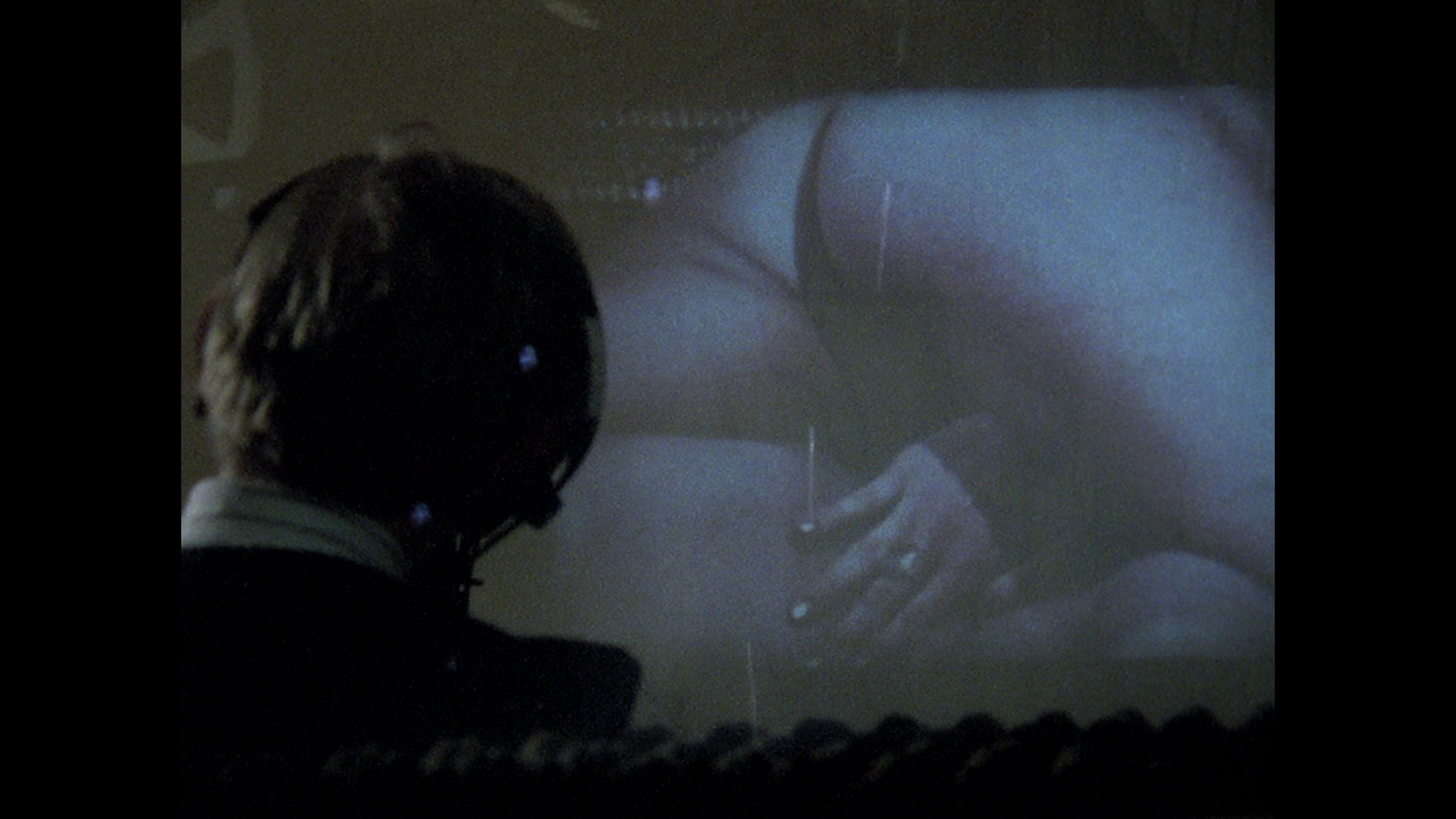 Lannie Blake suggests that for Monika and her friends, ‘it is no more perverse to watch the dismemberment of animals for pleasure than it is to look at heterosexual pornography’s reduction of people to their genitalia; it is simply more socially acceptable’ (ibid.). In contrasting Mark’s porno pictures with Monika’s videocassette, Buttgereit shows ‘an awareness of the politically problematic dimensions of visual pleasure’ and offers ‘no easy moralising’ and ‘none of the knee-jerk-will-to-censorship of the Autonome Szene’, the group of ‘political activists whom Franz Rodenkirchen deemed practitioners of “fascism from the left”’ (ibid., quoting Rodenkirchen). Buttgereit’s Nekromantik films feature a mixture of different media, ‘using Super-8, 8mm, 16m and 32mm film [sic], video, polaroids, stills-photography and television pictures in the construction of his representations of the dead and those who love them’ (ibid.). In Nekromantik 2 alone, Buttgereit mixes 16mm film (the base stock on which the picture as a whole was shot), Super 8mm footage post-processed into monochrome (the flashbacks from the first film), video (the videocassette footage of the seal’s being skinned), Polaroids (using a Polaroid camera, Monika takes a ‘couples’ photograph of herself and Rob’s corpse) and 35mm stills photography (Monika uses a 35mm SLR to document her and Mark’s ‘date’ to the funfair, and shows Mark her photograph album containing images of her dead relatives). Blake suggests that Buttgereit’s self-aware use of different types of photography ‘appears to affirm that the elegiac art of photography […] allows us not only “to participate in another person’s (or thing’s) mortality, vulnerability, mutability” but in the medium’s very will to “testify to time’s relentless melt”’ (ibid., quoting Susan Sontag). Lannie Blake suggests that for Monika and her friends, ‘it is no more perverse to watch the dismemberment of animals for pleasure than it is to look at heterosexual pornography’s reduction of people to their genitalia; it is simply more socially acceptable’ (ibid.). In contrasting Mark’s porno pictures with Monika’s videocassette, Buttgereit shows ‘an awareness of the politically problematic dimensions of visual pleasure’ and offers ‘no easy moralising’ and ‘none of the knee-jerk-will-to-censorship of the Autonome Szene’, the group of ‘political activists whom Franz Rodenkirchen deemed practitioners of “fascism from the left”’ (ibid., quoting Rodenkirchen). Buttgereit’s Nekromantik films feature a mixture of different media, ‘using Super-8, 8mm, 16m and 32mm film [sic], video, polaroids, stills-photography and television pictures in the construction of his representations of the dead and those who love them’ (ibid.). In Nekromantik 2 alone, Buttgereit mixes 16mm film (the base stock on which the picture as a whole was shot), Super 8mm footage post-processed into monochrome (the flashbacks from the first film), video (the videocassette footage of the seal’s being skinned), Polaroids (using a Polaroid camera, Monika takes a ‘couples’ photograph of herself and Rob’s corpse) and 35mm stills photography (Monika uses a 35mm SLR to document her and Mark’s ‘date’ to the funfair, and shows Mark her photograph album containing images of her dead relatives). Blake suggests that Buttgereit’s self-aware use of different types of photography ‘appears to affirm that the elegiac art of photography […] allows us not only “to participate in another person’s (or thing’s) mortality, vulnerability, mutability” but in the medium’s very will to “testify to time’s relentless melt”’ (ibid., quoting Susan Sontag).
The film, as presented here, is uncut and runs for 102:54 mins.
Video
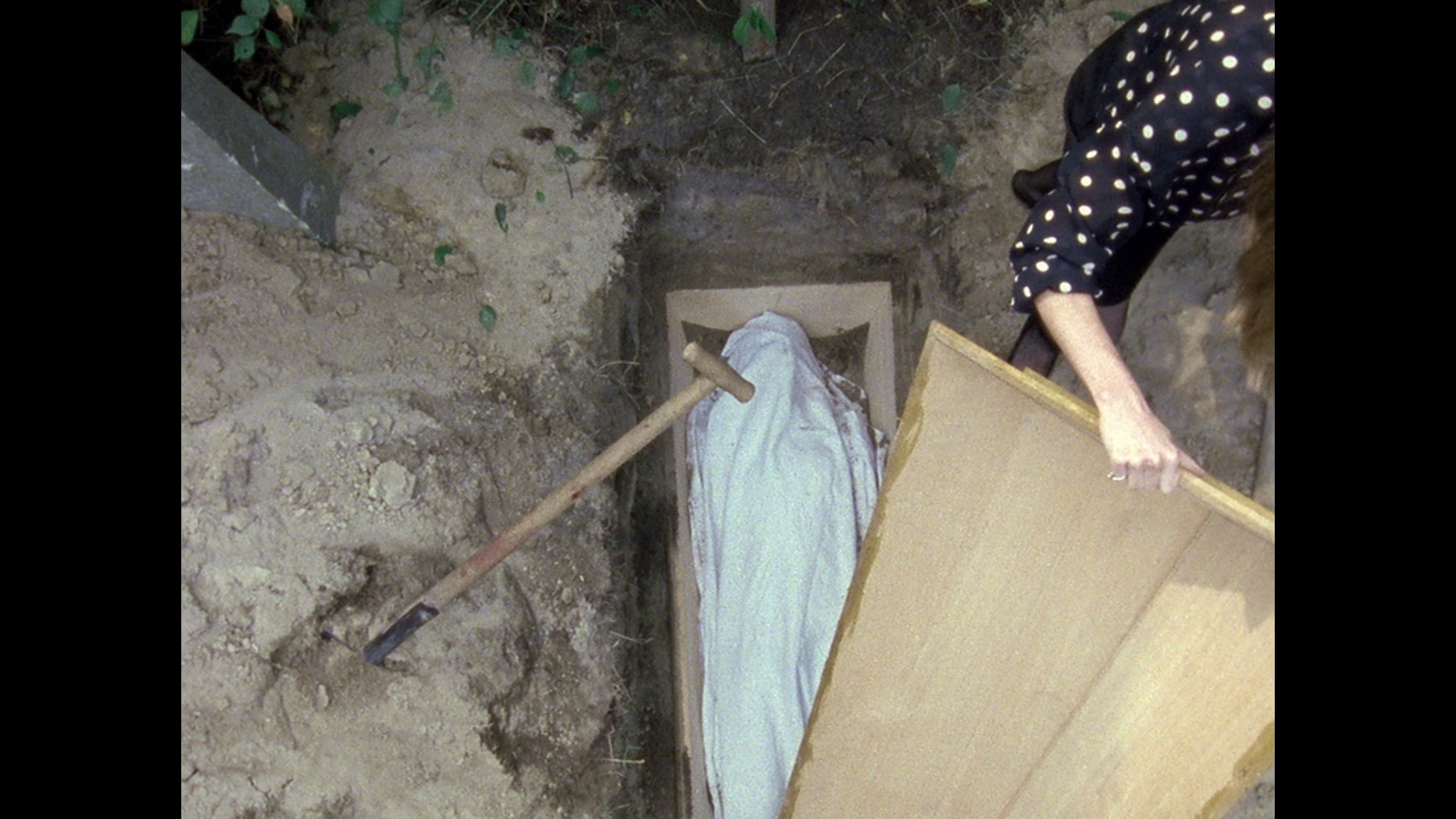 Nekromantik 2 is here presented in its original aspect ratio of 1.33:1. The 1080p presentation uses the AVC codec. Some damage is present here and there, but nothing too distracting or detrimental to the viewing experience. In the opening sequence, the improved colour reproduction (in contrast with the film’s previous DVD releases) is evident in the luscious greens of the grass within the cemetery and the deep browns of the earth into which Monika digs to exhume Rob’s corpse. The image is clear and detailed, with very nicely balanced contrast levels: there’s a wonderful balance between light and dark in this presentation, with strong and defined mid-tones. In contrast with this, the soft contrast of the videotaped footage (the cassette that Monika and her friends watch in her apartment) stands out like a sore thumb. Nekromantik 2 is here presented in its original aspect ratio of 1.33:1. The 1080p presentation uses the AVC codec. Some damage is present here and there, but nothing too distracting or detrimental to the viewing experience. In the opening sequence, the improved colour reproduction (in contrast with the film’s previous DVD releases) is evident in the luscious greens of the grass within the cemetery and the deep browns of the earth into which Monika digs to exhume Rob’s corpse. The image is clear and detailed, with very nicely balanced contrast levels: there’s a wonderful balance between light and dark in this presentation, with strong and defined mid-tones. In contrast with this, the soft contrast of the videotaped footage (the cassette that Monika and her friends watch in her apartment) stands out like a sore thumb.
NB. Some larger screengrabs are included at the bottom of this review.
Audio
Audio is presented via a LPCM 2.0 stereo track. (This is, naturally, in German.) The track is clear throughout, the dynamic range evidenced by the balance between the deep piano refrain on the soundtrack and the shrill violin that can be heard in some sequences. This track is accompanied by optional English subtitles which are clear and easy to read.
Extras
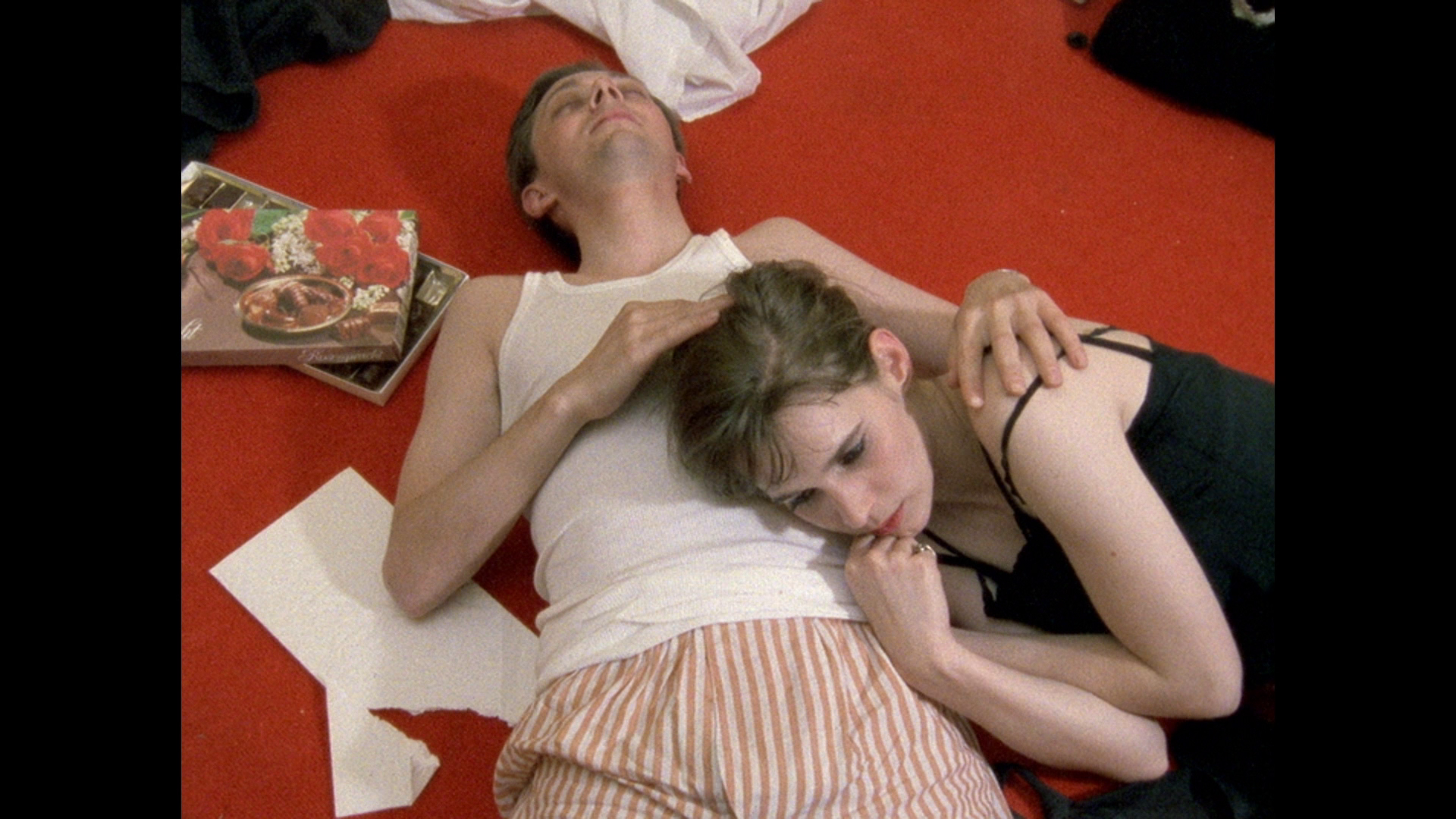 The disc includes a wide array of contextual material. The disc includes a wide array of contextual material.
- an audio commentary with Buttgereit, Monika M, Mark Reeder and writer Franz Rodenkirchen. This commentary track is in English and features all of the participants in fine form, reflecting on the film’s genesis, production and its reception. The track is filled with anecdotes, and the participants joke with one another throughout. It’s a highly entertaining, informative and ‘warm’ commentary track. - an optional introduction by Buttgereit, Monika M, Reeder and producer Manfred Jelinski (0:39). - a new documentary about the film, ‘Masters of Life and Death’ (36:58). Featuring input from Buttgereit, producer Manfred Jelinski, Monika M and Mark Reeder, this documentary sees the participants reflecting on the film’s production and engaging with its reception – both in terms of the controversy it provoked and the ways in which it has been interpreted by critics. Monika M in particular shows surprise about the ways in which the film has come to be accepted as a ‘classic’ of sorts by its fans. The participants all speak in English. - a featurette, ‘City of the Loving Dead’ (9:13). Here, in another newly-shot piece, Jelinski and Reeder offer a tour of the locations used in the film. - ‘Necropolis: Jorg Buttgereit’s Berlin’ (9:01). This new interview with Dr Marcus Stiglegger reflects on the picture, suggesting that watching it two decades after its production the film may be seen as ‘the myth of Berlin’. Stiglegger talks about the immediate context in which Buttgereit began to work as a filmmaker, examining the ways in which ideas about Berlin are depicted within Buttgereit’s films – and, obviously, Nekromantik 2 in particular. - ‘The Making of Nekromantik 2’ (27:45). This vintage featurette features plenty of behind-the-scenes footage, including colour footage from the shooting of the film-within-a-film, ‘Mon dejeuner avec Vera’. Preparation for some of the effects sequences are also shown in detail. The feaurette includes two audio tracks: (1) an English audio track which contains comments from Buttgereit, Monika M and writer Franz Rodenkirchen; and (2) a German track which features interviews with Buttgereit and Rodenkirchen. The latter is accompanied by optional English subtitles. - ‘Nekro Waltz’ (5:07). In a new interview, Mark Reeder talks about his music for the film. - Outtakes (11:05). This is simply a silent compilation of short bits of footage from the production of the film, featuring the crew setting up shots and Buttgereit shooting some stills photography of the production. Also included are some snippets of footage that obviously didn’t make the final cut of the picture, and some footage of the cast and crew larking about on the film’s set. - ‘Nekromantik 2 Livekoncert’ (11:43). Recorded in 2011, this is footage taken from before a screening of the film which features Monika M and others performing some of the film’s music in front of a live audience. - Two short films: ‘BLUTIGE EXZESSE IM FUHRERBUNKER ‘Bloody Excess in the Leader’s Bunker’ (1982) (7:59), based on the premise that Hitler survived the war and uses the corpse of Eva Braun to breed a new Nazi army; and ‘A Moment of Silence at the Grave of Ed Gein’ (2012) (2:03), a very short film which is simply a shot of Ed Gein’s grave. The former has an optional commentary, in English, by Buttgereit. - Two music videos made by Buttgereit: ‘Rise Up’ by The Krupps (1997) (4:02); and ‘Die Frau in der Musik’ by Stereo Total (2012) (2:17). - Trailers for Nekromantik (2:05), Der Todesking (2:28), Nekromantik 2 (1:13) and Schramm (1:28). - An image gallery (1:51). Retail copies also include the soundtrack CD, five Polaroid postcards (presumably representative of the Polaroids Monika captures in the film itself) and a limited edition 100 page book. The book includes a translation of an article that was submitted as part of the defense of the film against its prosecution in Germany, and new writing about the film by Keir La-Janisse and Virginie Sélavy.
Overall
 Bartlomiej Paszylk has asserted that although the acting in the picture ‘was laughable and the cinematography terrible’, the first Nekromantik ‘became a must-see for all the toughest horror fans’ owing to ‘the accumulation of disgusting, taboo-breaking scenes’ that ‘delivered more filthiness than they might have expected’ (Paszylk, 2009: 194). Nekromantik 2, Paszylk argues, is ‘a better acted and bigger-budgeted rehash of the first movie’ (ibid.). In the contextual material on this Blu-ray release, Buttgereit describes the film as a ‘romance [….] a love story, a triangle love story’, and he’s one hundred per cent right: it’s a film about a relationship, or rather a woman’s relationship with two men (Rob and Mark). One, Mark, is a disappointment in all respects, able to perform sexually but without desire; the other, Rob, is a blank canvas onto which Monika can project her own desire, and is disappointment only in the sense that he cannot perform sexually (obviously, owing to the fact that he’s dead). Monika finds a way to reconcile these two ‘failures’ of men, resulting in an epiphany that is both disturbing and deeply, darkly funny. Buttgereit’s next film, Schramm (1991), is arguably his best, but Nekromantik 2 is an interesting picture – certainly a challenging one for new viewers, given both its content and its slow pace, but a more nuanced picture than the first Nekromantik. All of this is enriched by the context in which Nekromantik 2 was made and the texture of Berlin, at a moment of change, as captured by the film. Bartlomiej Paszylk has asserted that although the acting in the picture ‘was laughable and the cinematography terrible’, the first Nekromantik ‘became a must-see for all the toughest horror fans’ owing to ‘the accumulation of disgusting, taboo-breaking scenes’ that ‘delivered more filthiness than they might have expected’ (Paszylk, 2009: 194). Nekromantik 2, Paszylk argues, is ‘a better acted and bigger-budgeted rehash of the first movie’ (ibid.). In the contextual material on this Blu-ray release, Buttgereit describes the film as a ‘romance [….] a love story, a triangle love story’, and he’s one hundred per cent right: it’s a film about a relationship, or rather a woman’s relationship with two men (Rob and Mark). One, Mark, is a disappointment in all respects, able to perform sexually but without desire; the other, Rob, is a blank canvas onto which Monika can project her own desire, and is disappointment only in the sense that he cannot perform sexually (obviously, owing to the fact that he’s dead). Monika finds a way to reconcile these two ‘failures’ of men, resulting in an epiphany that is both disturbing and deeply, darkly funny. Buttgereit’s next film, Schramm (1991), is arguably his best, but Nekromantik 2 is an interesting picture – certainly a challenging one for new viewers, given both its content and its slow pace, but a more nuanced picture than the first Nekromantik. All of this is enriched by the context in which Nekromantik 2 was made and the texture of Berlin, at a moment of change, as captured by the film.
Arrow’s beautifully-packaged new Blu-ray release of the film contains an excellent presentation of the main feature and some brilliant contextual material. Fans of the film, or Buttgereit’s work more generally, will find this release an absolute delight. References: Blake, Linnie, 2008: The Wounds of Nations: Horror Cinema, Historical Trauma and National Identity. Manchester University Press Halle, Randall, 2003: ‘Unification Horror: Queer Desire and Uncanny Visions’. In: Halle, Randall & McCarthy, Margaret (eds), 2003: Light Motives: German Popular Film in Perspective. Wayne State University Press: 281-303 Lugt, Kris Vander, 2013: ‘From Siodmak to Schlingensief: The Return of History as Horror’. In: Fisher, Jaimey (ed), 2013: Generic Histories of German Cinema: Genre and Its Deviations. New York: Camden House: 157-72 Paszylk, Bartlomiej, 2009: The Pleasure and Pain of Cult Horror Films: An Historical Survey. London: McFarland & Company 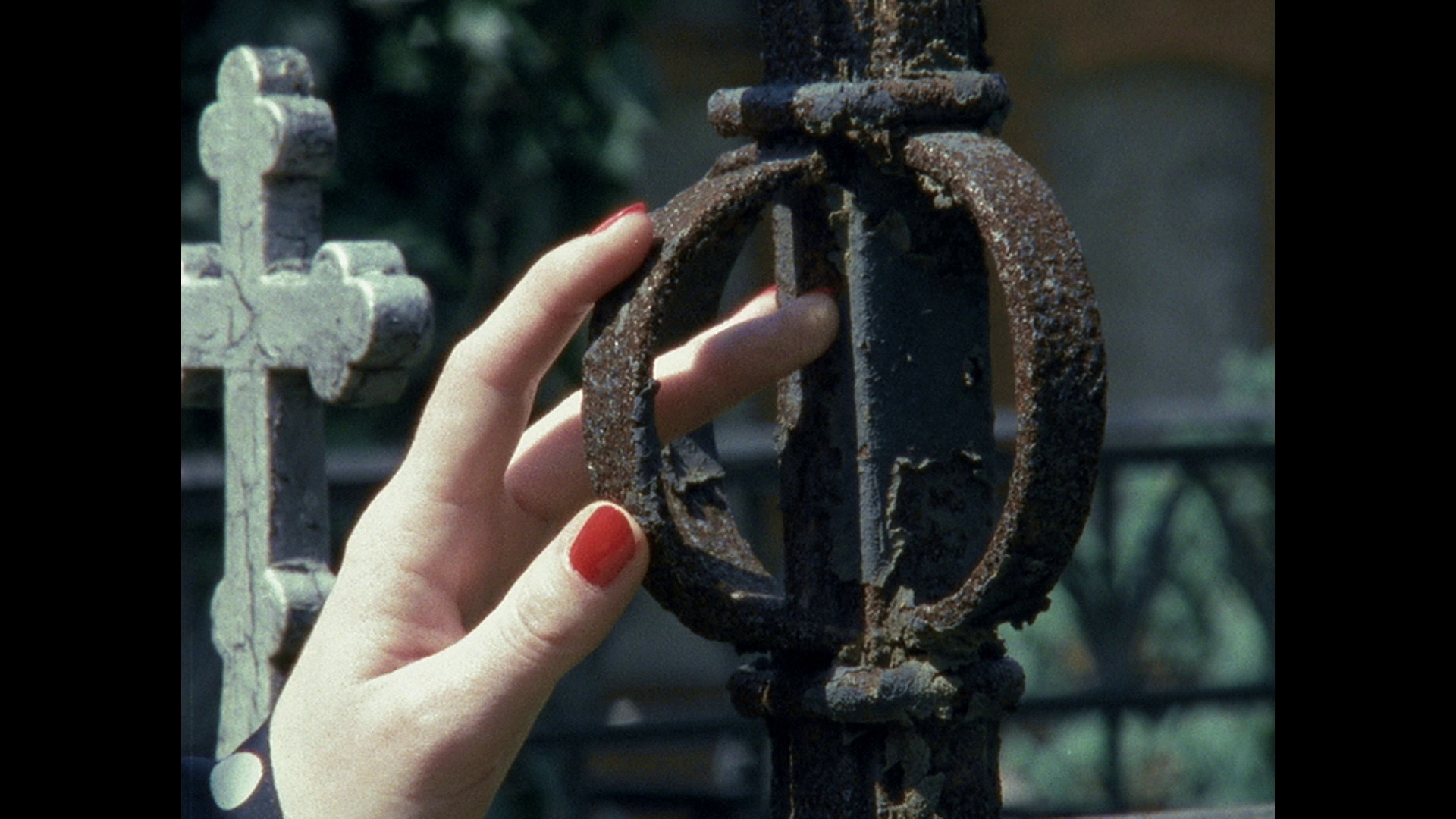
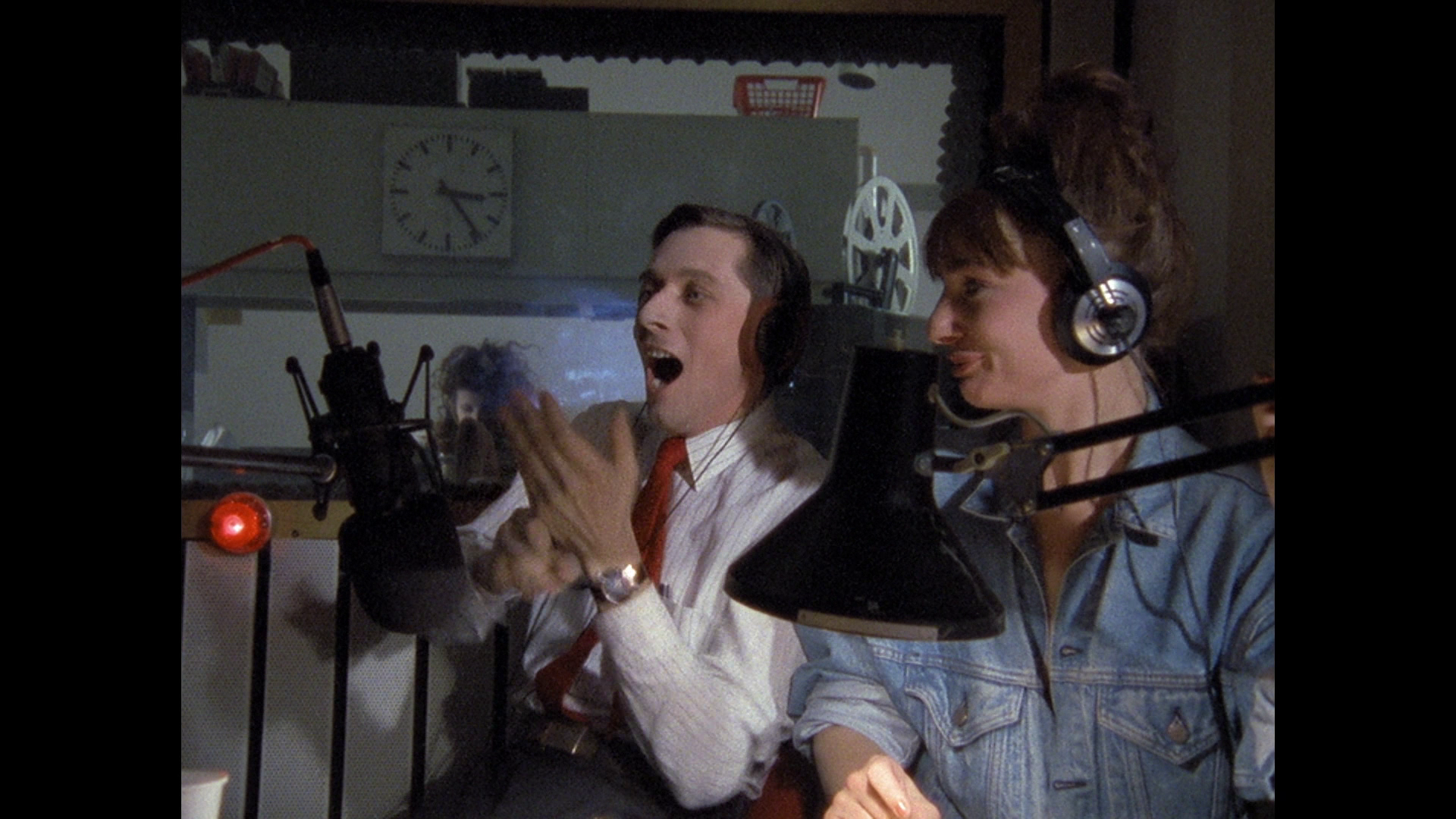


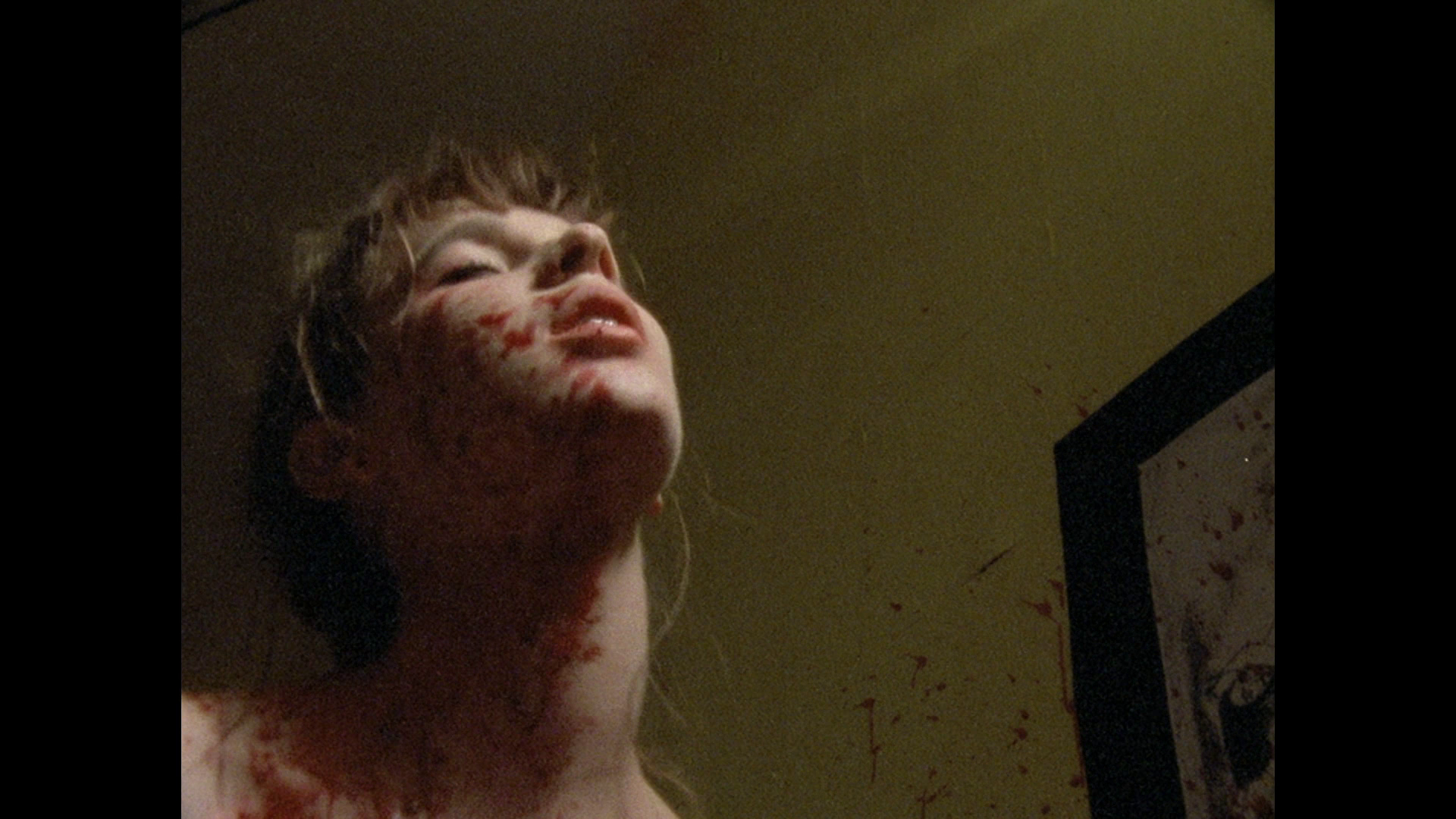
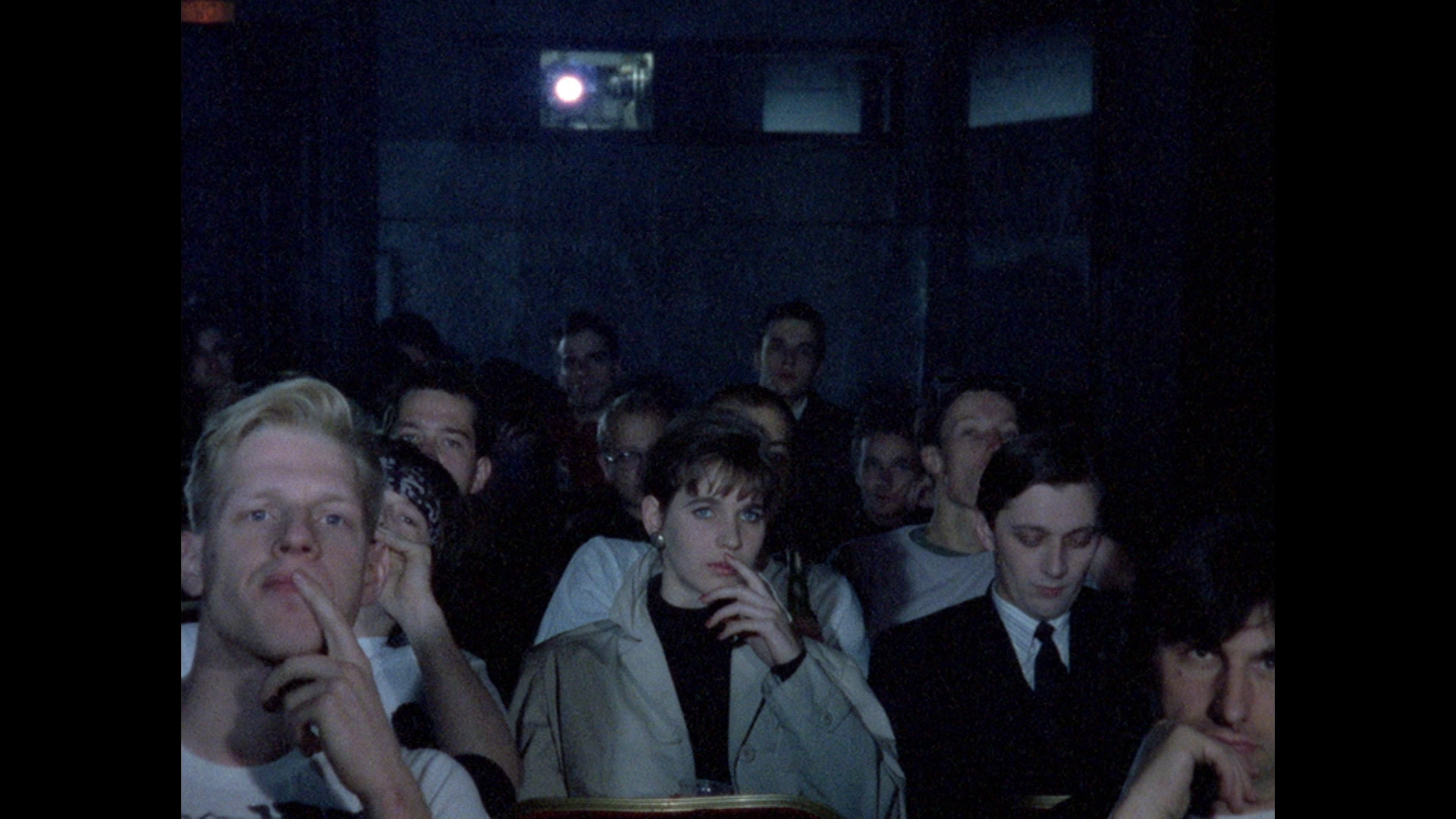
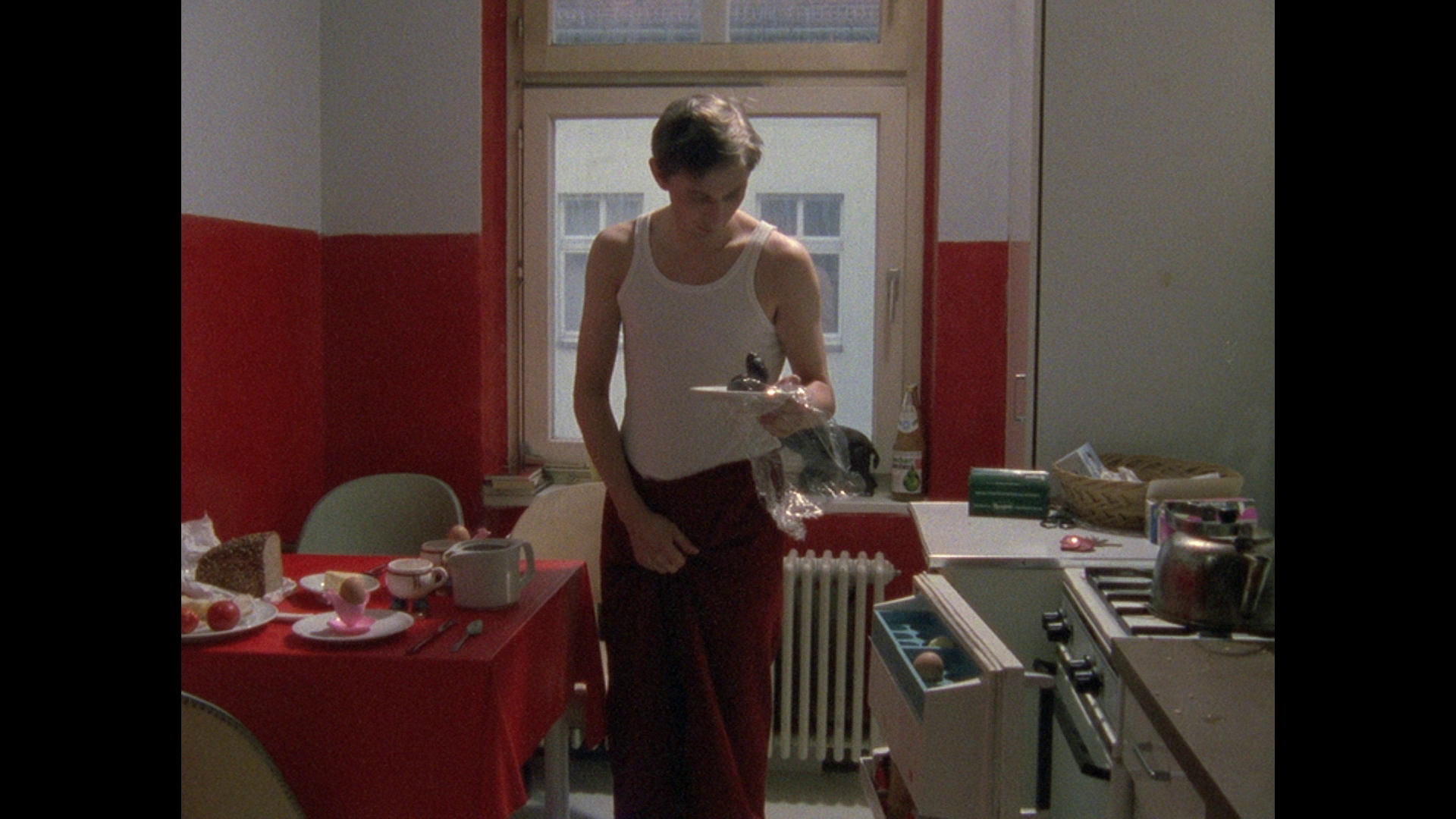
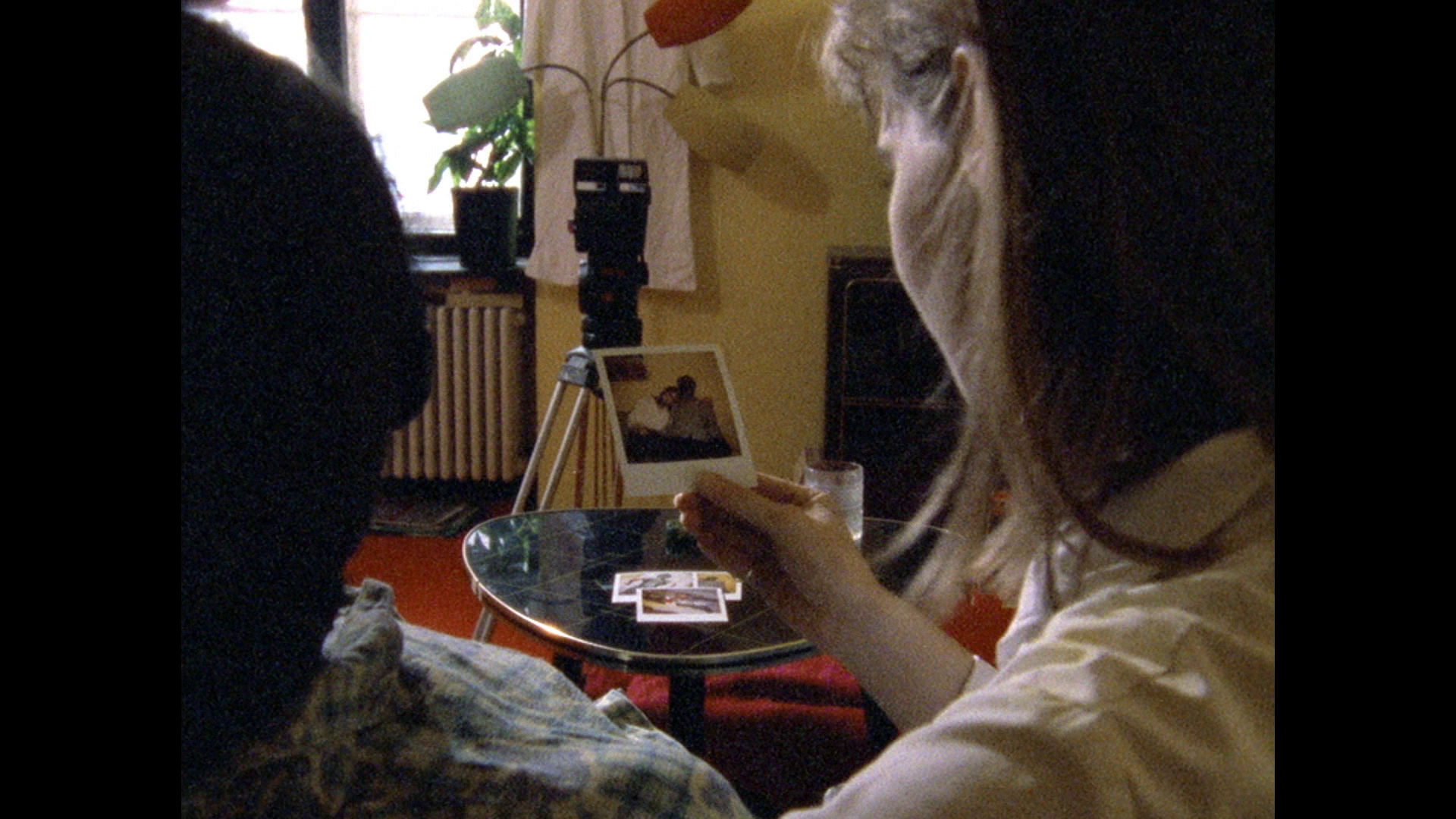
|
|||||

|